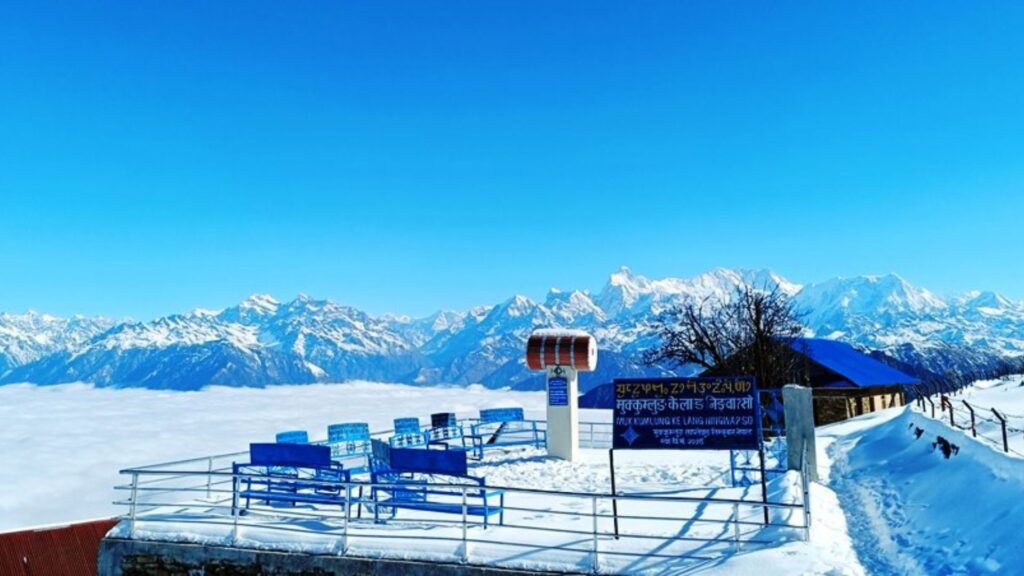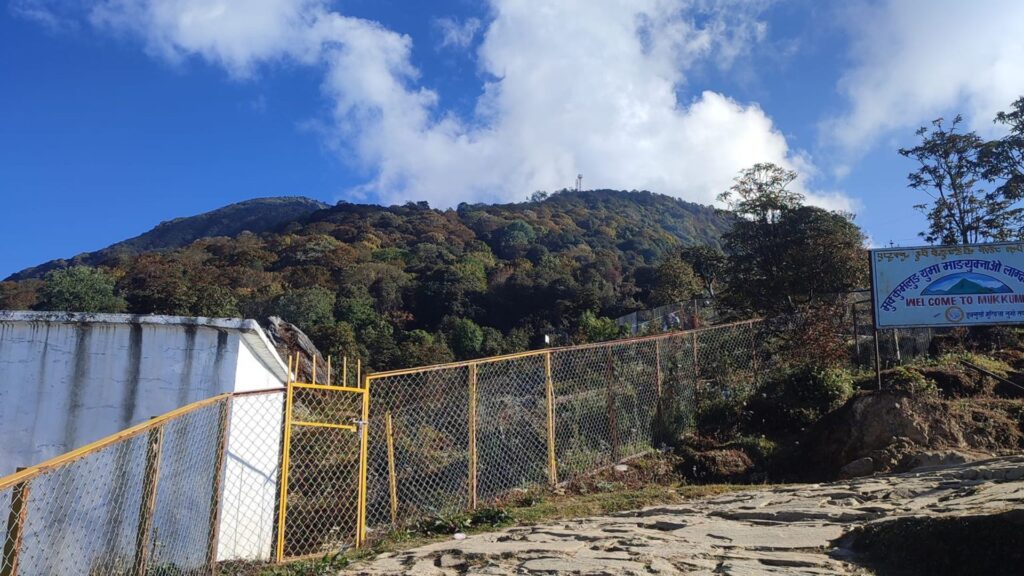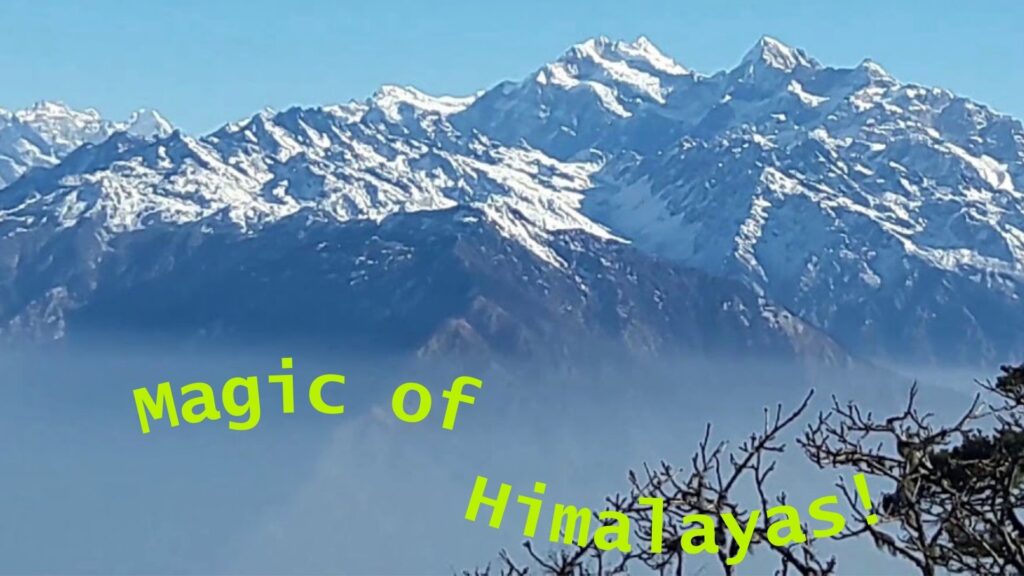Pathibhara (Mukkumlung)
Unveiling the Sacred Mystique of Pathibhara Devi: A Journey to Spiritual Bliss

Table of Contents
Introduction/Location of Pathibhara/Mukkumlung
- Goddess (Devi) Pathibhara is a divine symbol of power also known as ‘Shakti’ (Energy) [feminine power/energy] that is used against evil, negative, and wicked forces. She is believed to be the universe’s mother, so we called her ‘Pathibhara Mata’.
- Pathibhara also known as Mukkumlung Temple lies on a hill of Koshi Province Taplejung district Pathibhara Yangwarak Rural Municipality of eastern Nepal. Pathibhara’s name is taken from the shape of the hill. The pyramid-shaped hill where Pathibhara Devi temple stands is like a full-Pathi (Pathi: a grain-measuring traditional container of Nepal). The name Mukkumlung is taken from the Limbu language, it means the source and origin of power and purity.
- The temple is approximately 3,794 meters (12,448 feet) above sea level with latitude 27.4291° N, longitude 87.7682° E, and 19.4 km northeast of Phungling Bazaar.
- Devotees who built more temples in other places (Ilam, Panchthar, Tehrathum, Dhankuta, and more) are believed to be sisters. The temple’s remote location and accessibility depending on weather conditions may be the reason. all temples can be seen on a calm and clear day (from one temple location to another).
Significance
- Pathibhara Devi Temple is a revered Hindu including other “Omkar Family” pilgrimage sites dedicated to the Goddess of the universe ‘Pathibhara’.
- Worshippers from different parts of the world, mainly (the Omkar family: Hindu, Buddhist, Kirat, and more…) are believed to be a powerful goddess who fulfills the wishes of her devotees.
- The temple holds significant religious and cultural importance for the people of the Omkar family. After welcoming by Ding Dong sound from the series of hanging bells on both sides of the street, prayer flags of Buddhists with a chant to promote peace, compassion, strength, and wisdom. Kirati Manghim (place of worship) where Kiratis worship by lighting candles as per their tradition and culture located near the main Hindu temple. Along with their belief in the worship of nature like rivers, trees, mountains, etc. nowadays begin to feel the necessity of community worship, making more Manghim preserve their tradition, culture, and religion. Before entering the main Hindu Pathibhara Temple, worshipped a couple of lions (vehicle of Devi) at the main gate, the lions represent strength (energy), power, and courage. After that worshipped Ganesh known as the God of wisdom and obstacle remover. same way worshipped Shiva/Bhairav as God of destroyer and transformer, Symbol of Dissolution and Detachment, Lord of Meditation and Yoga, Giver of Boons and Blessings. worshiped Banabasi, River (Khola), Sikari, and Pitri for removing obstacles, well-being of the family, and for obtaining their blessings. coconuts are offered to Pathibhara Devi as a symbol of purity, fertility, and prosperity. Breaking a coconut during a ritual is a common practice. It symbolizes the breaking of the ego and the surrender of oneself to the divine. devotees offer ‘Chura’, clothes, and more which she loved and wore. After the worship of Pathibhara Devi, the Prasad is distributed among family members and guests as a symbol of blessings and divine grace.

Mythological Background
- According to Hindu mythology: Pathibhara Mata is one among Fifty-One ‘Shakti Peeths’ (Self-immolation body parts of Goddess Sati had fallen on different places during Lord Shiva’s sad world tour) While Lord Shiva was roaming around the world taking self-immolation body of Goddess Sati. The throat (body part) of the goddess Sati was fallen on this place where the temple stands. Devi Parbati (rebirth of Goddess Sati) lived for a long time by praying to get married to Lord Shiva and rejoined then this place is a unique holy place for Hindus.
- Saying that local shepherds lost hundreds of their sheep while grazing on the place where the temple stands today. on the searching transition of lost sheep, they had a dream in which the goddess ordered them to carry out ritualistic sacrifice of some (saying that 5) sheep and build a shrine in her honor. After the sacrifice was offered, the lost sheep recovered. Since that day, people started ritualistic offerings of animals (goat, duck, chicken…). instead of ritual offerings, more followers have started to offer gold, silver, and money.
- Pathibhara also known as Aadi Kali, Maha Maya, and Maha Rudri temple is a revered Hindu including other “Omkar Family” pilgrimage sites dedicated to Goddess Pathibhara Devi.
- Worshippers from different parts of the world, mainly the Omkar family (Omkar family: Hindu, Buddhist, Kirat, and more…) believe that a powerful goddess who is considered the source of power, energy, courage, and destroys evil brings goodness, fulfills wishes of her devotees.
- The temple holds significant religious and cultural importance for the people of the Omkar family.

Architectural Features
- The temple architecture of Pathibhara/Mukkumlung reflects traditional ‘Pagoda’ design elements of the Omkar family.
- A pagoda temple is a religious structure that combines the architectural features of a pagoda with its cultural and religious significance. At the same time, many other Kirati and Buddhist architectural features have been built around there.

Wonder of the Pilgrimage Journey
- The journey to Pathibhara Devi Temple often involves a trek, and pilgrims undertake this journey as part of their spiritual experience. there is a saying that if the journey is too easy, the blessing may not be granted. For taking domestic flights, the nearest cities with good air connectivity to Taplejung (Suketar airport) are Kathmandu and Biratnagar. From Biratnagar, Bhadrapur, and Birtamod, easily can find local buses and other rented offroad vehicles to Taplejung Phungling Bazzar or Suketar through Illam and Panchthar. rented off-road vehicles are available at Phunling Bazzar or Suketar to Kafle Pati then start the trekking route for 2 to 4 hours for the final destination. Pathibhara trekking trail also is the best option for the trekking lover, The route starts from Basantapur through Chauki, Gupha Pokhari, Nesum, Dovan, Suketar, Pathibhara Phedi to Pathibhara.
- The wonder of the pilgrimage journey/trek offers breathtaking views of the surrounding Himalayan landscapes. the majestic peak of Mt Kumbhakarna (Jannu Himal) the 32nd and Mt Kanchenjunga the 3rd highest mountain in the world ranking accompanies visitors throughout the climb and the 360-degree view from the summit is stunning. Even those who are not particularly religious are overwhelmed by a feeling of exhilaration from the panorama, the crisp cold air, and the mysterious energy of the shrine that pulls many to it.
- Journey along with the forests are lush with oak and rhododendron giving way to pine and alpine meadows. the full bloom of rhododendrons with many colors like pink, red striped, and sometimes solid and striped flowers on the same tree are waiting for welcome.

Festivals
- Various festivals are celebrated at Pathibhara Devi Temple, attracting many tourists and devotees. Mainly during Navaratri ([“Nine nights” in Sanskrit]: Day 1 – Pratipada, Day 2 – Dwitiya, Day 3 – Tritiya, Day 4 – Chaturthi, Day 5 – Panchami, Day 6 – Shashthi, Day 7 – Saptami, Day 8 – Ashtami and Day 9 – Navami), the goddess is worshipped, All Navaratris (Chaitra [Basanta] Navaratri: the lunar month of Chaitra {march-April}, Magha Navaratri: the lunar month of Magha {January-February}, Ashada Navaratri: the lunar month of Ashada {June-July} and Sharada [Autumn] Navaratri: the lunar month of Aaswin also called Aasvini {September-October}) attract a significant number of devotees and participants. Especially in Magha Navaratri, harsh weather conditions, such as heavy snow or extreme cold, discourage tourists and devotees from visiting and attending gatherings or events. This is because travel becomes more difficult, and individuals may prioritize safety and warmth over visiting or attending activities. Altitude sickness also known as Acute Mountain Sickness (AMS) can occur, it is caused by the body’s response to the lower levels of oxygen available at higher elevations.
- During festivals, special rituals and ceremonies take place, adding to the spiritual ambiance. Many devotees observe fasts during Navaratri as a form of purification and devotion and perform daily prayers and pujas dedicated to the Goddess. it is a tradition to listen to the recitation of the verses from the scripture “Chandi Path”.
Local Culture
- The region surrounding the Pathibhara/Mukkumlung temple is rich in local culture and traditions. Hinduism is a diverse religion with numerous festivals celebrated throughout the year, some major Hindu festivals are Dashain (Navaratri with Durga Pooja), Deepawali (Diwali), Shivaratri, Basanta Panchami, Holi (Phagu Purnima), Ram Navami, Buddha Jayanti, Ganesh Chaturthi, Krishna Janmashtami, Raksha Bandhan and more… with classical and Traditional dance and song/Bhajan depends on festival like Deusi in Deepawali, Durga Bhajan in Dashain, Krishna bhajan in Krisnastami any many more especially in each festival. Kirati (Rai, Limbu, and more…) have a rich cultural heritage with various festivals that reflect their traditions, beliefs, and customs. Some of the prominent Kirati festivals include: Sakela (Sakela Ubhauli and Sakela Udhauli), Udhauli or Udhauli Parva, Ubhauli or Ubhauli Parva, Chandi Purnima, Yele Sambat and more… Chandi Nach and Yalang (Dhan Nach) are famous dance form celebrated with cultural song like Palam and more… Similarly, Lakhe Nach (Dance) is famous in Newar community and Lhosar and Buddha Jayanti are famous in Tamang, Sherpa, Gurung and more… communities.
- Pilgrims may experience the hospitality and customs of the local communities during their journey of Mukkumlung/Pathibhara.
Conservation and Tourism

- Efforts have been in place to preserve the natural environment around the temple.
- Sustainable tourism practices have encouraged to protection of the cultural and ecological balance.
- Pathibhara View Tower, the unique view of the hills and gorges made by the silver and golden (sunrise and set time) shining mountain range to the north is stunning from the Pathibhara Hill which is also being built as a natural lookout point. Can get many positive emotions like calmness, joy, and creativity and can facilitate concentration and many more advantages during communication with Mt Kumbhakarna, Kanchenjunga, Everest, Lhotse, Cho Oyu, and Makalu.
Accessibility
- The temple’s remote location requires a trek, and accessibility depends on weather conditions.
- Pilgrims and tourists need to plan their journey with consideration for the terrain and climate.
- The best time for Pathibhara trekking is March to June and September to November. For more details on the pilgrimage journey.
- planning to access through Cable car in Pathibhara/Mukkumlung but now facing local objection and still under consideration.

Accommodation
- Depending on the development in the area, there will be basic accommodations available for pilgrims and tourists in Mukkumlung/Pathibhara area. If someone gets sick by altitude sickness or other various reasons, can get support from local people who are helping by carrying a sick person on a medical/local stretcher.
Conclusion
- Hoping this blog will help and guide you as GPS/Compass to explore the natural, cultural, spiritual, and religious beauty of Pathibhara. even though the world is vast, each place has unique magic. if you set your foot on this extraordinary place, it opens your heart, broadens your mind, and fills your life with joyful surprises.
- Please verify this information with more recent sources as there may have been changes or updates. If you have specific details or updates in mind, I recommend checking with local authorities or recent travel resources for the most accurate and current information.
- ‘Jobs fill your pocket but adventure fills your soul.’
- may divine blessings of goddess Pathibhara/Mukkumlung fill your life with joy, happiness, and prosperity.
